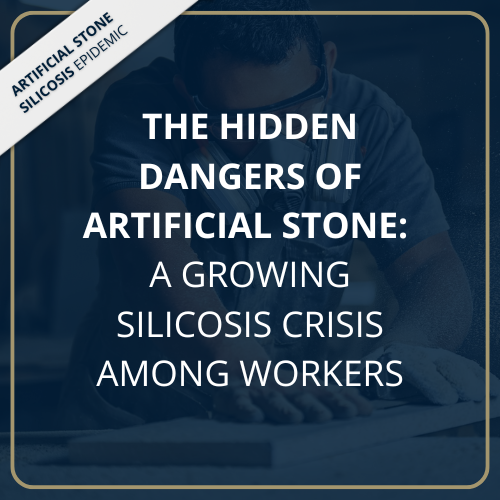
Exploring the Effectiveness of Dust Control for Safer Worker Environments
June 10, 2024
Predictors of Psychological Stress in Silica-Exposed Workers in the Artificial Stone Benchtop Industry
July 12, 2024Engineered stone, renowned for its durability and aesthetic appeal, has become a staple in modern construction, particularly for kitchen and bathroom countertops. However, while much attention has been given to the dangers of respirable crystalline silica (RCS) in engineered stone fabrication, a recent study by Chandnee Ramkissoon and colleagues sheds light on another potentially hazardous aspect: the release of volatile organic compounds (VOCs) during the cutting and finishing processes.
The Study at a Glance
Ramkissoon et al. conducted a forensic analysis to identify the organic compounds released during the dry-cutting of engineered stone. Using a combination of pyrolysis-gas chromatography-mass spectrometry (GC-MS) and traditional capture and analysis techniques, they screened emissions from twelve engineered stone products. The results revealed significant findings, particularly the presence of lung irritants such as phthalic anhydride and styrene.
Key Findings
1. Prevalence of Phthalic Anhydride and Styrene:
- Phthalic anhydride was found to be the most common and abundant compound, constituting 26-85% of the total organic composition of the emissions. This compound is known for its respiratory sensitization properties, which can induce hypersensitivity and respiratory irritation.
- Styrene, another prevalent compound, was identified as the predominant VOC emitted during active cutting. Both phthalic anhydride and styrene are classified as lung irritants, posing significant health risks to workers.
2. Diverse Organic Compounds:
- Other detected VOCs included benzaldehyde, benzene, ethylbenzene, toluene, and acetone. These compounds are products of organic decomposition and can have various health implications, including central nervous system effects and carcinogenic potential.
3. Health Implications:
- The study emphasizes the potential for concurrent exposure to high levels of RCS and harmful VOCs during engineered stone fabrication. Such dual exposure could exacerbate respiratory conditions, including asthma, chronic bronchitis, and potentially more severe lung diseases.
Methodology
The study involved dry-cutting the engineered stone samples in a controlled environment to capture the dust and VOC emissions. The dust was analyzed for its organic content using pyrolysis-GC-MS, while VOCs were actively sampled and screened during the cutting process.
- Pyrolysis-GC-MS: This technique allowed the researchers to identify the composition of organic compounds in the dust.
- Active Sampling: Conducted during the cutting of a selected engineered stone sample (ES10), this method captured a suite of 73 VOCs, with styrene and phthalic anhydride being specifically targeted due to their abundance in the initial screening.
Results and Discussion
The analysis revealed that the dust from dry-cutting engineered stones contained 8.6-20% resin and 80-91% RCS. The most abundant organic compounds identified were phthalic anhydride and styrene, followed by benzaldehyde and other lesser-known compounds.
- Phthalic Anhydride: Detected ubiquitously, it is known to cause respiratory issues, including asthma and chronic bronchitis.
- Styrene: Commonly used in the manufacture of plastics and resins, styrene exposure has been linked to various pulmonary health effects.
The study's findings highlight the critical need to address not only the RCS content in engineered stones but also the organic compounds released during their fabrication. These organic compounds, especially phthalic anhydride and styrene, can volatilize during cutting, potentially reaching workers' breathing zones and causing respiratory irritation.
Conclusion and Recommendations
The study by Ramkissoon et al. is pioneering in its detailed analysis of the organic emissions from engineered stone fabrication. It underscores the importance of considering both RCS and VOC exposures to comprehensively assess the health risks faced by workers in this industry.
Recommendations for Mitigation:
- Concurrent Sampling: When assessing workplace exposure, it's crucial to sample for both RCS and VOCs to understand the full spectrum of potential hazards.
- Enhanced Ventilation and PPE: Implementing improved ventilation systems and ensuring proper use of personal protective equipment (PPE) can help mitigate the risks associated with VOC exposure.
- Further Research: More studies are needed to explore the interactions between RCS and VOCs and their combined effects on respiratory health.
This study opens new avenues for occupational health research and highlights the need for comprehensive safety protocols in the engineered stone industry to protect workers from multifaceted hazards. The insights from this study can lead to improved occupational safety standards and help mitigate health risks in the engineered stone industry.
Take Action and Protect Your Rights with Brayton Purcell
If you work in the engineered stone industry and are concerned about artificial stone silicosis, it's vital to understand your rights and options. The silica exposure attorneys at Brayton Purcell LLP specialize in representing workers exposed to hazardous working conditions.
Our stone cutter lung injury attorneys are committed to helping you receive the protection and compensation you deserve. Contact us to discuss how we can assist you in navigating legal challenges and ensuring your workplace is safe.
Reach out to a silicosis lawsuit attorney from Brayton Purcell LLP and together we can work to make your workplace safer.
References
- Ramkissoon, C., Gaskin, S., Hall, T., Pisaniello, D., & Zosky, G. (2024). Engineered Stone Fabrication Work Releases Volatile Organic Compounds Classified as Lung Irritants. Occupational and Environmental Medicine.














